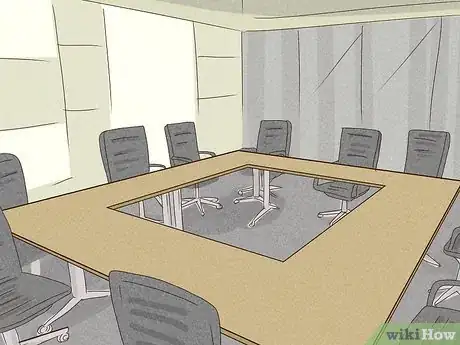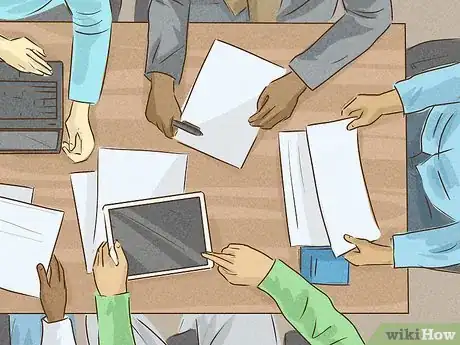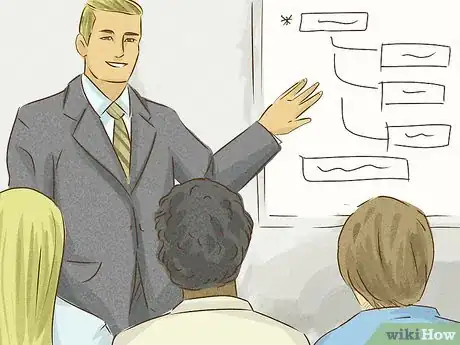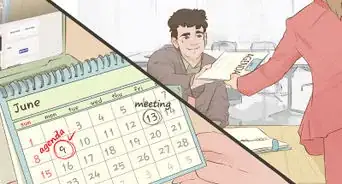This article was co-authored by Dave Labowitz. Dave Labowitz is a Business Coach who helps pre-entrepreneurs, solopreneurs/entrepreneurs, and team leaders start, scale, and lead their businesses and teams. Before beginning his coaching career, Dave was a startup executive who spent over a decade building high-growth companies. Dave’s “path less traveled” life includes adventures such as dropping out of high school, co-authoring a book in the Smithsonian Institute, and getting his MBA at Pepperdine’s Graziadio Business School.
wikiHow marks an article as reader-approved once it receives enough positive feedback. This article has 16 testimonials from our readers, earning it our reader-approved status.
This article has been viewed 319,980 times.
Business work, especially in an office setting, demands a certain degree of collaboration. For instance, important decisions often call for more than one person's perspective and important work often needs the expertise of multiple people to get done. Meetings are one way to make collaboration structured and organized, but without a sense of purpose or control, meetings can easily become overlong and inefficient. Knowing how to plan, prepare, and lead a meeting that you're chairing can make the difference between an effective meeting and a wasted one.
Steps
Preparing for the Meeting
-
1Discuss the upcoming meeting with your attendees. When you learn that you’ll be chairing an upcoming meeting, one of the first things you should do is to spend a little time talking to the people who will be attending (especially high-ranking or important people). Ask them if there’s anything they’d specifically like to discuss at the meeting. Take note of their answers and use them to guide you when you write your agenda.
- Asking your attendees about what they’d like to discuss is a smart move not only because it makes it easier to write an agenda, but also because it engages them in the meeting process before it’s even begun. People are more likely to attend and pay attention during meetings if they know that issues important to them will be addressed.
- Knowing the topic of the meeting allows you to be more confident when speaking.
-
2Write and distribute an agenda. A meeting agenda can be a valuable tool not just for a meeting’s chairperson, but also for the guests in attendance. Agendas contain valuable information about the meeting like when it will be, where it will take place, and who will be in attendance. Most importantly, they also outline all of the intended topics of discussion, allowing everyone to prepare. Send your meeting out in advance of the meeting itself — the more important your meeting is, the earlier you should send it.[1]
- One thing that your agenda should definitely contain is an approximate time limit for each topic of discussion. Having a rough schedule outlined beforehand makes it much easier to keep your meeting on-track. Though some items on your agenda may run long (and others may run short), a schedule makes it much easier to keep track of these items and adjust accordingly.
Advertisement -
3Research the discussion topics and any previous meetings. The people who attend your meeting may not be up-to-speed on all of the topics you plan to discuss — some may not have attended past meetings, while others may have simply forgotten. As the meeting chair, it’s a good idea to know the history of discussion thus far. Try talking to people who attended previous important meetings to learn any important unfinished business that you should address in your meeting. You may also want to request the minutes of past meetings from an official record-keeper to help direct your planning.
- The minutes from previous meetings can be an important resource to you as chair. These summarize the discussions and decisions that occurred during past meetings, making it relatively quick and easy to get up-to-speed. You may even want to distribute important meeting minutes to your attendees with your agenda.
-
4Get your meeting space ready ahead of time. On the day of your meeting, you’ll want to ensure that the room or place you intend to meet in is clean, presentable, and ready to accommodate your attendees. You’ll want to make certain that any technological components of the meeting (like presentations, projectors, displays, etc.) are functioning properly and are completely ready to go — technical snafus can waste valuable time and put your meeting off track.[2]
- If you're using an electronic presentation (like PowerPoint, etc.), take a moment to familiarize yourself with the remote control or clicker you'll be using to cycle through your slides. You don't want to waste time fumbling with your controls when you could be discussing important issues.
Acting as Chair During the Meeting
-
1Call the meeting to order. When the meeting reaches its scheduled start time and all of the attendees (or at least all of the important ones) are present, get the attention of everyone in the room. Introduce yourself as the chair and state the purpose of the meeting. Establish the intended time frame for the meeting by informing everyone of the ending time you're shooting for — you may run long or short, but stating your intended time limit ahead of time helps keep the meeting on-track. If some of the attendees aren't familiar with one another, take a moment to conduct a brief roll call and introduce important attendees.
- Note that some businesses and organizations have strict, regimented procedures for opening and conducting a meeting. For instance, the American Federation of State, County, and Municipal Employees (AFSCME) uses a system called Robert's Rules of Order which includes calling the meeting to order by banging a gavel and very specific rules for introducing and passing motions.
-
2Sum up relevant points from previous meetings. At the start of meetings that are part of a long, ongoing project, you'll want to briefly catch all of the attendees up on the state of the project thus far by quickly summarizing any relevant events or decisions from previous meetings. Not everyone in attendance may be as knowledgeable about the topics of discussion as you are, so quickly bringing everyone up to speed can go a long way towards making your meeting an efficient and effective one.[3]
- Rather than summarizing previous meetings yourself, you may want to have an official scribe or record-keeper read the minutes from previous meetings to give the summary a sense of formality.
- You may also consider reading any important correspondences or communications that have occurred since the previous meeting.
- Note that if you provide copies of the minutes/correspondence to attendees, reading aloud isn't generally required.
-
3Allow important attendees to report on the state of affairs. Next, allow people with relevant knowledge to inform the assembly of new or recent developments that have occurred since the last meeting. These can be virtually anything — for instance, new problems facing your business or organization, personnel changes, project developments, and strategy changes can all be addressed here. Meeting attendees will also want to hear about the results of any specific actions that were taken because of decisions made at the last meeting.
-
4Address any unfinished business. If there are any problems that remain unsolved or decisions that haven't been made from the last meeting, make an effort to address these before moving on to new problems. The longer that old problems are put off, the less that any attendee will want to take responsibility for them, so try to pin down and resolve any lingering unfinished business during your meeting. Usually, unfinished business is specifically noted as "undecided" or "tabled for future discussion" in minutes from previous meetings.
- Depending on the culture and rules where you work, your business or organization may have specific procedures for reaching a decision — for instance, the meeting attendees may simply need to reach a majority consensus, or a select group of high-ranking individuals may be tasked with all decision-making.
- Note that some things are just too big to complete between meetings. You don't necessarily need to dwell on the progress of long-term projects that aren't finished yet. You should, however, bring up decisions or projects where present action is required.
-
5Address any new business. Next, bring up new problems, concerns, and issues that need to be discussed. These should be things that naturally stem from the developments that have occurred between any previous meetings and the present. Try to obtain concrete, definite decisions from the attendees — the more items you leave undecided, the more unfinished business you'll have to bring up next meeting.
-
6Summarize the conclusions of the meeting. When you've addressed all past and present business, take a moment to sum up the conclusions of the meeting for everyone in attendance. Break down the results of all the decisions that were made and, if necessary, describe the specific actions that attendees will be expected to take before the next meeting.
- This step is crucial — it's your last chance to make sure that everyone leaves the meeting knowing exactly where your projects stand and what is expected of them.
-
7End by laying the groundwork for the next meeting. Finally, tell everyone what to expect for the next meeting and, if you've already begun to plan it, tell them when and where to expect it to be. This helps give the attendees the sense of continuity from one important project or decision to the next and gives them a time frame for progressing or completing their assigned tasks.
- Note that you don't necessarily have to plan another meeting if you address all past and present business at your current one. However, if there's enough unfinished business to warrant future discussion or you're waiting to see how certain projects develop, it's probably a good idea.
Leading the Meeting Effectively
-
1Guide the discussion, but don’t dominate it. One of your roles as the meeting chair is to keep the discussion moving and on-task. Your role is not to offer opinion on every single issue or keep the discussion on an exact schedule. Have some flexibility. Let the other attendees talk freely and allow new topics of discussion to arise even if they're not on the agenda. You may find that you need to subtly end or change certain topics of conversation to keep the discussion on track, but you shouldn't feel as if you have to control every aspect of the meeting. After all, it's a collaborative process.
- As the meeting progresses, keep an eye on your agenda. If you're running behind, you may need to skip certain topics of discussion or table them for later in the interests of time. Don't be afraid to do this if the topics that are being discussed are very important ones.
-
2Encourage all attendees to participate. As the meeting chair, your job is to ensure an open, productive discussion. If you notice that certain attendees who may have knowledge relevant to the issues at hand aren't opening up to the group, encourage them to talk. You don't have to challenge or call them out directly — simply saying something along the lines of, "I think Mrs. Smith's expertise would be useful here" is a great way to get less-active members of the meeting engaged.[4]
-
3Make sure everyone understands what is being discussed. It can be difficult to remember that not everyone attending the meeting has the same amount of experience or knowledge in the topics of discussion. To make sure everyone attending the meeting has spent their time wisely, you may want to take the opportunity to briefly simplify complex issues or topics when they come up. The less-knowledgeable attendees will undoubtedly appreciate this.
-
4Don’t ignore difficult or awkward questions. If they're not kept under control by a competent chair, meetings can be remarkably unproductive. Try to make sure that every important issue you came to discuss gets addressed. Don't allow attendees to blame-shift or offer vague excuses for problems that haven't been addressed. Try to pin down and obtain answers for issues that no one wants to address. Though this isn't necessarily what every attendee will want, these sorts of awkward questions are precisely the ones that need to be answered the most for the meeting to be as effective as possible.
- Make sure important decisions are recorded (if you have official record-keepers or minute-takers, assign them this task). If you're going to go the trouble of asking the hard questions, you'll want to make sure that the answers you get are well-documented.
-
5Keep track of your time. There's a reason meetings have a bad reputation — for many, they're thought of as serious wastes of time. To prevent your meeting from running long, use your power as chair to keep the discussion moving. Don't be afraid to table certain unimportant issues or conversations until a later date if your meeting seems to be taking longer than you expected. Be ready and willing to adjust your schedule on the fly to make sure that none of your attendees' precious time is being wasted.[5]
Expert Q&A
-
QuestionHow do you confidently chair a meeting?
 Dave LabowitzDave Labowitz is a Business Coach who helps pre-entrepreneurs, solopreneurs/entrepreneurs, and team leaders start, scale, and lead their businesses and teams. Before beginning his coaching career, Dave was a startup executive who spent over a decade building high-growth companies. Dave’s “path less traveled” life includes adventures such as dropping out of high school, co-authoring a book in the Smithsonian Institute, and getting his MBA at Pepperdine’s Graziadio Business School.
Dave LabowitzDave Labowitz is a Business Coach who helps pre-entrepreneurs, solopreneurs/entrepreneurs, and team leaders start, scale, and lead their businesses and teams. Before beginning his coaching career, Dave was a startup executive who spent over a decade building high-growth companies. Dave’s “path less traveled” life includes adventures such as dropping out of high school, co-authoring a book in the Smithsonian Institute, and getting his MBA at Pepperdine’s Graziadio Business School.
Business Coach Preparation is key! The more preparation you do and the more ready you are to speak, the more confidence you'll have. It also helps to remind yourself that the outcome of the meeting doesn't necessarily reflect on you. Everyone is striving toward a goal and is tied to the same mission. Ideally, everyone is in alignment and working toward the same thing, so it's not just on you to reach that outcome on your own.
Preparation is key! The more preparation you do and the more ready you are to speak, the more confidence you'll have. It also helps to remind yourself that the outcome of the meeting doesn't necessarily reflect on you. Everyone is striving toward a goal and is tied to the same mission. Ideally, everyone is in alignment and working toward the same thing, so it's not just on you to reach that outcome on your own. -
QuestionHow do you prepare to chair difficult meetings?
 Dave LabowitzDave Labowitz is a Business Coach who helps pre-entrepreneurs, solopreneurs/entrepreneurs, and team leaders start, scale, and lead their businesses and teams. Before beginning his coaching career, Dave was a startup executive who spent over a decade building high-growth companies. Dave’s “path less traveled” life includes adventures such as dropping out of high school, co-authoring a book in the Smithsonian Institute, and getting his MBA at Pepperdine’s Graziadio Business School.
Dave LabowitzDave Labowitz is a Business Coach who helps pre-entrepreneurs, solopreneurs/entrepreneurs, and team leaders start, scale, and lead their businesses and teams. Before beginning his coaching career, Dave was a startup executive who spent over a decade building high-growth companies. Dave’s “path less traveled” life includes adventures such as dropping out of high school, co-authoring a book in the Smithsonian Institute, and getting his MBA at Pepperdine’s Graziadio Business School.
Business Coach Talk to other people that have hosted or attended meetings on a similar topic so you can learn more about your subject matter. Even if they don't have experience on the exact topic of your meeting, you can still learn some best practices of how to run a more efficient meeting.
Talk to other people that have hosted or attended meetings on a similar topic so you can learn more about your subject matter. Even if they don't have experience on the exact topic of your meeting, you can still learn some best practices of how to run a more efficient meeting. -
QuestionWhat should the chair say when the meeting is getting off track?
 Community AnswerPerhaps, "Ladies and gentlemen, it appears we have gotten off track. Let's return to the reason we're here."
Community AnswerPerhaps, "Ladies and gentlemen, it appears we have gotten off track. Let's return to the reason we're here."
References
- ↑ https://meetingtomorrow.com/blog/how-to-chair-a-successful-meeting/
- ↑ https://meetingtomorrow.com/blog/how-to-chair-a-successful-meeting/
- ↑ https://hbr.org/1976/03/how-to-run-a-meeting
- ↑ https://hbr.org/1976/03/how-to-run-a-meeting
- ↑ https://www.businessballs.com/communication-skills/meetings-how-to-plan-and-run-meetings/
- https://www.diycommitteeguide.org/app/uploads/2022/09/Chairing-meetings.pdf
- http://www.resourcecentre.org.uk/information/chairing-a-meeting/
About This Article
To chair a meeting, make sure everyone understands what’s being discussed by giving a brief overview of each agenda item. Then, encourage all attendees to participate by asking for input from less vocal members, saying something like “I think Mrs. Smith’s expertise would be useful here.” While it’s your role to keep the discussion moving and on task, try to avoid controlling every aspect of the meeting. Additionally, try to address any unfinished business from the last meeting before moving onto new ones. For more tips, like how to prepare an agenda, read on!



















-Step-23.webp)
























-Step-23.webp)


































